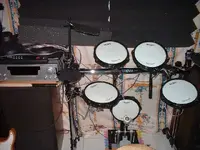S
Speedy VonTrapp
New member
I've spent a little time now looking for answers to my question here, and I've gotten some, but I'd like a bit more, so I've decided to ask a question.
How does one go about triggering a drum kit? This is a potentially long answer, but that's what I'm looking for.
I know that I can buy parts from Radio Shack for the triggers, and I've seen some diagrams on how to put them together, etc.
Most of the information that I've found is pretty limited to that, however.
Can someone give me a blow by blow of the entire process?
Say I buy the parts, and make some triggers. What is next?
Do I need to buy some sort of processor for the triggers? Can they be connected to my computer via midi cables? I really just don't know what to do with them once I've got them made.
Is it better to use them on a fake kit, or put them on a real kit, and use both sounds mixed to taste? Certainly, there would be just opinion issues with this question, but that's ok.
I'm looking to find out what it will take from start to finish. If someone can point me to an article that does this, or let me know what I would need to buy, as far as hardware that the triggers plug into, that would be awesome.
Thank you,
-Speedy
How does one go about triggering a drum kit? This is a potentially long answer, but that's what I'm looking for.
I know that I can buy parts from Radio Shack for the triggers, and I've seen some diagrams on how to put them together, etc.
Most of the information that I've found is pretty limited to that, however.
Can someone give me a blow by blow of the entire process?
Say I buy the parts, and make some triggers. What is next?
Do I need to buy some sort of processor for the triggers? Can they be connected to my computer via midi cables? I really just don't know what to do with them once I've got them made.
Is it better to use them on a fake kit, or put them on a real kit, and use both sounds mixed to taste? Certainly, there would be just opinion issues with this question, but that's ok.
I'm looking to find out what it will take from start to finish. If someone can point me to an article that does this, or let me know what I would need to buy, as far as hardware that the triggers plug into, that would be awesome.
Thank you,
-Speedy


